| Alexandra Fiord is on the eastern side of Ellesmere Island at approximately 78 degrees north
latitude. This area has seen human habitation for thousands of years. Early Inuit inhabitated
this area and built dwellings sunk into the ground and covered by skins. We spent several
weeks kayaking on the Arctic Ocean.
|
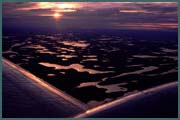
| DC3 Sunset.
Our regularly scheduled jet flight to Resolute was cancelled due to a radar outage.
So we chartered a 50 year old DC3 and flew from Edmonton to Resolute. A DC3 is not a
fast plane - about as fast as a well-tuned Ferrari. We were flying due north, so the
sun just hovered above the horizon. I spent 3 hours watching this sunset.
|
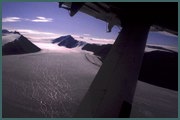
| Ellesmere Glacier.
After 13 hours in the air, we landed at Resolute where we transferred to a Twin Otter,
the taxi cab of the high Arctic. A three hour flight over Cornwallis Island, Devon
Island, and Ellesmere Island brought us to Alexandra Fiord. The "runway" was a short
section where someone had removed the bigger rocks - but it was still much rougher than
any normal road. I'll swear a Twin Otter could land on a dime.
|
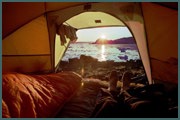
| Sunrise.
It was early August, and the sun would actually drop a bit below the horizon at night.
This was the sight that greeted me early one morning. The ice in the bay would move
back and forth as the tide ebbed and flowed. We were lucky - no mosquitos, so the tent
door stayed open unless it was blowing and raining.
|
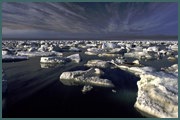
| Sea Ice.
This is typical of some of the sea ice that we had to kayak through. In general, it
wasn't too difficult. but you had to go slowly and steer your way around many of the
ice chunks.
|
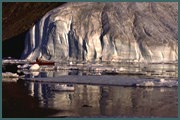
| Glacier Toe.
We kayaked by many glaciers that descended from the high icefields on Ellesmere Island.
The glaciers here tend to move quite slowly, so there wasn't too much chance of an
iceberg calving off when we were in the vicinity.
|
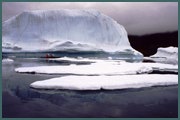
| Large Iceberg.
We encountered many large icebergs. Most of them would have originated from northern
Greenland. They would move back and forth with the tide, and would often run aground.
Wave and tide action would erode the iceberg at the waterline, and often produce an
overhanging ledge.
|






